|
|
 |
carlo carra
|
|
Carlo Carra (February 11, 1881 ?C April 13, 1966) was an Italian painter, a leading figure of the Futurist movement that flourished in Italy during the beginning of the 20th century. In addition to his many paintings, he wrote a number of books concerning art. He taught for many years in the city of Milan. |
|
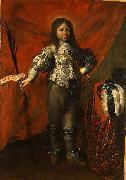 |
Carlo Ceresa
|
|
Carlo Ceresa (January 20, 1609 - January 29, 1679) was an Italian painter of the Baroque period active mainly around Bergamo.
His early life and training are poorly recorded. He likely trained in Bergamo. He visited Venice, yet esconced himself in the small town of San Giovanni Bianco in Val Bembrana. Mostly recalled for his portraiture, Ceresa also painted altarpieces and religious works in an understated fashion. |
|
 |
Carlo Crivelli
|
|
1430-1495
Italian
Carlo Crivelli Locations
1495). He produced many large, multi-partite altarpieces in which his highly charged, emotional use of line, delight in detail, decoration and citric colours, often set against a gold ground, convey an intensity of expression unequalled elsewhere in Italy. His mastery of perspective was also used for dramatic impact. As he worked in isolation in the Marches, his style only had local influence. In the 19th century, however, he was one of the most collected of 15th-century Italian painters. |
|
|
|
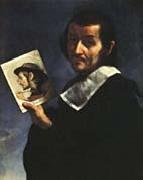 |
Carlo Dolci
|
|
Italian Baroque Era Painter, 1616-ca.1686
was an Italian painter of the Baroque period, active mainly in Florence, known for highly finished religious pictures, often repeated in many versions. He was born in Florence, on his mother's side the grandson of a painter. Although he was precocious and apprenticed at a young age to Jacopo Vignali, Dolci was not prolific. "He would take weeks over a single foot", according to his biographer Baldinucci. His painstaking technique made him unsuited for large-scale fresco painting. He painted chiefly sacred subjects, and his works are generally small in scale, although he made a few life-size pictures. He often repeated the same composition in several versions, and his daughter, Agnese Dolci, also made excellent copies of his works. Dolci was known for his piety. It is said that every year during Passion Week he painted a half-figure of the Saviour wearing the Crown of Thorns. In 1682, when he saw Giordano, nicknamed "fa presto" (quick worker), paint more in five hours than he could have completed in months, |
|
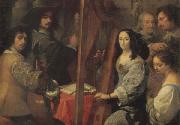 |
Carlo Francesco Nuvolone
|
|
Italian Baroque Era Painter, 1609-1662
was an Italian painter of the Baroque period, active mainly in Lombardy. He was born in Milan to an Cremonese father and mannerist painter, Panfilo Nuvolone. After working with his father, he studied under Giovanni Battista Crespi (il Cerano) in the Accademia Ambrosiana in Milan. In that studio he would have encountered Daniele Crespi and Giulio Cesare Procaccini. Of particular interest is his depiction of himself as a painter surrounded by his family of artists |
|
 |
Carlo Innocenzo Carlone
|
|
(1686-1775) was an Italian painter and engraver, active especially in Germany.
He was a native of Scaria, near Como, in Lombardy, but may have been from the Carloni family of Genoese painters. He was the son of a sculptor, but he preferred painting, and was placed under the care of Giulio Quaglio. He afterwards studied at Venice and at Rome, until he was 23 years of age, when he visited Germany, where he has left works in oil and in fresco at Ludwigsburg, Passau, Linz, Breslau, Prague, and Vienna.
He painted large decorative fresco cycles for palaces in Vienna, Prague and Southern Germany. For example, Carlone is known for painting the ceiling images in the Upper Belvedere of the Belvedere palace complex. His The Glorification of Saints Felix and Adauctus (1759-61) was commissioned for the cupola of the church of San Felice del Benaco on Lake Garda. He died at Como.
|
|
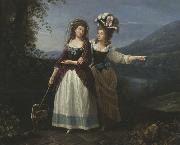 |
Carlo Labruzzi
|
|
painted Aleksandra and Izabela Potocki taking a stroll near to lake Albano in 1779-1780
|
|
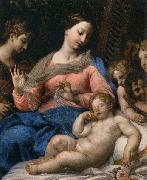 |
Carlo Maratta
|
|
(13 May 1625 - 15 December 1713) was an Italian painter, active mostly in Rome, and known principally for his classicizing paintings executed in a Late Baroque Classical manner. Although he is part of the classical tradition stemming from Raphael, he was not exempt from the influence of Baroque painting and particularly in his use of colour. His contemporary and friend, Giovanni Bellori, wrote an early biography on Maratta.
|
|
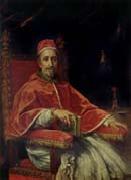 |
Carlo Maratti
|
|
Italian Baroque Era Painter, 1625-1713,Italian painter, draughtsman and printmaker. He was the last major Italian artist of the classical tradition that had originated with Raphael, and his pre-eminence among the artists of his time marks the triumph of classicism. Nonetheless his art unites the virtues of disegno and colore, and he created a grandiose and decorative style that satisfied the demands of the Church. |
|
|
|
|
|
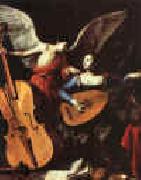 |
Carlo Saraceni
|
|
1580-1620
Italian
Carlo Saraceni Galleries
Carlo Saraceni (Venice 1579-Venice, 16 June 1620) was an Italian early-Baroque painter, whose reputation as a "first-class painter of the second rank" was improved with the publication of a modern monograph in 1968.
Though he was born in Venice, his paintings are distinctly Roman in style; he moved to Rome in 1598, joining the Accademia di San Luca in 1607. He never visited France, though he spoke fluent French and had French followers and a French wardrobe. His painting, however, was influenced at first by the densely forested, luxuriantly enveloping landscape settings for human figures of Adam Elsheimer, a German painter resident in Rome; "there are few landscapes by Saraceni which have not been attributed to Elsheimer," Malcolm Waddingham observed, and Anna Ottani Cavina has suggested the influences may have travelled both ways. and Elsheimer's small cabinet paintings on copper offered a format that Saraceni employed in six landscape panels illustrating The Flight of Icarus; in Moses and the Daughters of Jethro and Mars and Venus.
Saint Sebastian
Castle Museum, PragueWhen Caravaggio's notorious Death of the Virgin was rejected in 1606 as an altarpiece suitable for a chapel of Santa Maria della Scala, it was Saraceni who provided the acceptable substitute, which remains in situ, the only securely dated painting of his first decade in Rome. He was influenced by Caravaggio's dramatic lighting, monumental figures, naturalistic detail, and momentary action (illustration, right), so that he is numbered among the first of the "tenebrists" or "Caravaggisti". Examples of this style can be seen in the candlelit Judith and the Head of Holofernes.
Saraceni's matured rapidly between 1606 and 1610, and the next decade gave way to his fully mature works, synthesizing Caravaggio and the Venetians. In 1616?C17 he collaborated on the frescoes for the Sala Regia of the Palazzo del Quirinale. In 1618 he received payment for two paintings in the church of Santa Maria dell'Anima. The compositional details of his fresco of The Birth of the Virgin in the Chapel of the Annunciation of the church of Santa Maria in Aquiro are repeated in a panel on copper at the Louvre
In 1620 he returned to Venice, where he died in the same year. He was so influential on the style of an anonymous still life painter working in Rome, that the man is known as "Pensionante del Saraceni" |
|
 |
Carlos de Haes
|
|
Spanish
1826-1898
Carlos de Haes Galleries
Spanish painter of Belgian birth. In 1835 he moved with his parents to M?laga, where he studied under the court portrait painter and miniature painter Luis de la Cruz y R?os (1776-1853). In 1850 he returned to Belgium and studied with the landscape painter Joseph Quineaux (1822-95). During his studies there and on his travels in France, Germany and Holland, he became acquainted with contemporary Realist trends. He returned to Spain in 1855, becoming a naturalized Spaniard, and the following year he exhibited numerous landscapes at the Exposici?n Nacional, Madrid, to much acclaim. In 1857 he won the competition for the fourth chair of landscape painting at the Escuela de Bellas Artes in Madrid with View of the Royal Palace from the Casa de Campo (1857; Madrid, Real Acad. S Fernando), a work showing characteristics of the Barbizon and Fontainebleau landscape schools. In 1860 he was elected Acad?mico de m?rito at the Real Academia de S Fernando in Madrid. By 1861 he was officiating and drawing up the regulations for the landscape competitions for aspiring pensionnaires. Consequently plein-air works came to be required in place of the previous tradition of submitting historical landscapes executed in the studio, a practice that discouraged the study of nature. De Haes suggested that only final corrections should be made in the studio, an attitude that indicates his timid initiation and acceptance of Realist trends. |
|
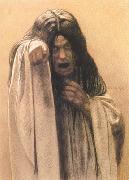 |
Carlos Schwabe
|
|
German Symbolist Painter, 1877-1926
Swiss painter and printmaker of German birth. He became a Swiss citizen and received his artistic training under Joseph Mittey (b 1853) at the Ecole des Arts Decoratifs in Geneva. Following brief success there, Schwabe moved to Paris where he supported himself as a designer of wallpaper while he developed considerable graphic skills. He soon became active in Symbolist circles, winning favour as an illustrator of mystical religious themes. His highly refined drawings and watercolours accompany texts such as Le Reve by Emile Zola (published 1892; drawings, Paris, Pompidou; exhibited Sociot Nationale des Beaux-Arts, also in 1892), Baudelaire's Les Fleurs du mal (1900), Maeterlinck's Pellias et Melisande, Catulle Mendes's L'Evangile de l'enfance de notre Seigneur Jesus-Christ selon Saint Pierre (1900) and Albert Samain's Jardin de l'Infante (1908). |
|
|
|
 |
carmignani
|
|
(born January 22, 1945 in Altopascio) is an Italian professional football coach and a former player.
|
|
 |
Carnicero, Antonio
|
|
Spanish, approx. 1748-1814
Painter and draughtsman, son of Alejandro Carnicero. He arrived at the Court in Madrid with his father in 1749 and took part in the competitions held by the Real Academia de S Fernando, winning second prize in 1769 with the Coronation of Alfonso XI and Queen Mary in the Monastery of Huelgas de Burgos (Madrid, Real Acad. S Fernando, Mus.). In 1760 he won a scholarship to Rome, subsequently winning prizes from the Accademia di S Luca. On his return to Madrid in 1766 he worked as a portrait painter, producing works such as the portrait of Do?a Tomasa de Aliaga, Widow of Salcedo (Madrid, Prado). In 1788 he was elected an honorary member of S Fernando. Under the protection of the Spanish prime minister, Manuel Godoy, Prencipe de la Paz, whom he painted on several occasions , and after painting the portraits of Charles IV and Maria Luisa (both Madrid, Monasterio de la Encarnacien), he was appointed Pintor de Cemara in 1796. In 1798 he applied unsuccessfully for the post of drawing-master to the Prince of Asturias, the future Ferdinand VII, although by 1806 he was teacher of the Infante Princes. He was a refined draughtsman and prepared illustrations for the editions of Cervantes's El ingenioso hidalgo Don Quixote de la Mancha published by the Real Academia Espa?ola (Madrid, 1780; 1782). He also made the drawings for the handsome engravings (Madrid, Calcografra N.) of the Real Picadero (Royal Riding School). In addition to his portraiture, which displays a talent for realism and wit, although at times combined with slightly garish colours, Carnicero executed attractive and descriptive costumbrista paintings, depicting everyday life, popular gatherings and hunting scenes, for instance Duck Shooting on the Albufera, Valencia |
|
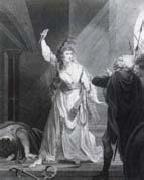 |
Caroline Watson
|
|
British 1760-1814,Daughter of James Watson. In 1780 she signed a stipple print of Isaac Watts and was soon employed by John Boydell (e.g. Prince William of Gloucester, 1784, after Joshua Reynolds). In 1785 she became Engraver to Queen Charlotte (1744-1818), a keen print collector. She was particularly fitted to working after miniatures, such was the delicacy of her engraving, and some of her best prints are portraits and small subjects after Samuel Shelley (c. 1750-1808). She did private commissions of this kind, notably for the Bute family, and also engraved large plates, some for the Boydell Shakespeare Gallery, including the Death of Cardinal Beaufort (1792) after Reynolds, allegedly at his request. She was employed by William Hayley (1745-1820) on his Life of George Romney Esq (London, 1809), and the correspondence involved shows her as a reliable and respected professional. |
|
|
|
|
|
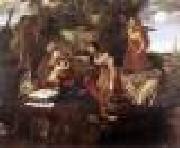 |
CAROSELLI, Angelo
|
|
Italian painter, Roman school (b. 1585, Roma, d. 1652, Roma)
Italian painter. He was the son of a dealer in second-hand goods and taught himself to paint. According to Baldinucci, he knew Caravaggio, who fled Rome in 1606, and this association may have encouraged his decision to become a painter. After visits to Florence (1605) and Naples (1613), Caroselli settled in Rome, where, in 1615, he married a Sicilian, Maria Zurca. His weakness for beautiful women was notorious (Baldinucci; Passeri). His second marriage, to Brigitta Lauri, daughter of the Flemish painter Balthasar Lauwers or Lauri (1578-1645), |
|
|
|
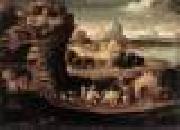 |
CARPI, Girolamo da
|
|
b. 1501, Ferrara, d. 1556, Ferrara
His father Tommaso ( fl 1503-23) was a painter and decorator at the court of the Este in Ferrara, and Girolamo was trained in the workshop of Garofalo. He visited Rome in the early 1520s (Fioravanti Baraldi) and was in Bologna in 1525, where he worked with Biagio Pupini and Giovanni Borghese on the decoration of the sacristy of S Michele in Bosco. Around this time (1525) he painted the altarpiece of the Virgin Enthroned with Saints |
|
|
|
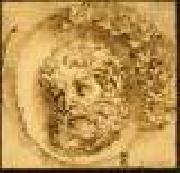 |
CARRACCI, Agostino
|
|
Italian Baroque Era Painter, 1557-1602
Painter, engraver and draughtsman, cousin of Ludovico Carracci. He abandoned his profession as a tailor, which was also that of his father, Antonio, and began training as a painter. According to Faberi, he studied first in the workshop of the painter Prospero Fontana (like Ludovico), then trained under the engraver and architect Domenico Tibaldi and under the sculptor Alessandro Menganti (1531-c. 1594). However, it is likely that Faberi's account was influenced by his desire to present Agostino's career as an example of the versatile 'cursus studiorum' advocated by the Accademia degli Incamminati. Other sources (Mancini, Malvasia, Bellori) agree that it was his cousin Ludovico who was responsible for directing him towards painting. |
|
 |
CARRACCI, Annibale
|
|
Italian Baroque Era Painter, 1560-1609
Painter, draughtsman and printmaker, brother of Agostino Carracci. Since his lifetime, he has been considered one of the greatest Italian painters of his age. His masterpiece, the ceiling (1597-1601) of the Galleria Farnese, Rome, merges a vibrant naturalism with the formal language of classicism in a grand and monumental style. |
|
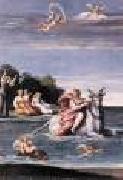 |
CARRACCI, Antonio
|
|
Italian Baroque Era Painter, ca.1583-1618
Painter, son of Agostino Carracci. He was born either c. 1583 (Baglione) or in 1589 (Bellori). His mother was a Venetian courtesan named Isabella. After his father's death, he joined the Roman household of his uncle Annibale Carracci. While Antonio may have collaborated with other studio assistants on the wall frescoes (1603-4) of the Galleria Farnese and the decoration (1606; commissioned from Francesco Albani) of some rooms in the Palazzo Mattei di Giove, Rome, his earliest undisputed works date from after Annibale's death in 1609. At that time, according to Monsignor G. B. Agucchi (Malvasia), Antonio returned briefly to Bologna, with the intention of joining Ludovico Carracci's studio, but the proposed collaboration came to nothing. A frescoed Vision of St Francis in the lower oratory of S Colombano was most probably painted during this Bolognese sojourn, and his Burial of Christ (Rome, Gal. Borghese) dates from c. 1609. He returned to Rome in 1610 and assisted Guido Reni in the Pauline Chapel of the Palazzo del Quirinale, where he painted Virtues and other subsidiary figures on the walls. |
|
|
|
|
|
|
|
 |
Casilear John William
|
|
American Hudson River School Painter, 1811-1893
was an American landscape artist belonging to the Hudson River School. Casilear was born in New York City. His first professional training was under prominent New York engraver Peter Maverick in the 1820s, then with Asher Durand, himself an engraver at the time. Casilear and Durand became friends, and both worked as engravers in New York through the 1830s. By the middle 1830s Durand had become interested in landscape painting through his friendship with Thomas Cole. Durand, in turn, drew Casilear's attention to painting. By 1840 Casilear's interest in art was sufficiently strong to accompany Durand, John Frederick Kensett, and artist Thomas P. Rossiter on a European trip during which they sketched scenes, visited art museums, and fostered their interest in painting. Casilear gradually developed his talent in landscape art, painting in the style that was later to become known as the Hudson River School. By the middle 1850s he had entirely ceased his engraving career in favor of painting full-time. He was elected a full member of the National Academy of Design in 1851, having been an associate member since 1831 |
|
 |
Caspar David Friedrich
|
|
1774-1840 Caspar David Friedrich Locations German painter, studied art at Copenhagen, and in 1798 settled in Dresden. Friedrich painted chiefly landscapes and seascapes, with and without figures, architectural pictures, including a few of Dresden, and some religious subjects. Religious feeling and symbolism permeate his œuvre, of which the seascape with figures, Die Lebensstufen, is a characteristic example. He possessed considerable power to convey mood in landscape. Almost forgotten in the 19th c. and early 20th c., interest in his work increased considerably in the mid-20th c. He is hardly represented in Britain, but an exhibition of 112 of his pictures at the Tate Gallery in 1972 attracted much attention. F. G. Kersting was a friend of Friedrich. |
|
 |
caspar netscher
|
|
Caspar (or Gaspar) Netscher (Heidelberg, 1639 ?C Den Haag, January 15, 1684) was a Dutch portrait and genre painter. He was a master in depicting oriental rugs, silk and brocade and introduced an international style to the Northern Netherlands.
Little is know of Netscher's early years. According to Arnold Houbraken's 17th century biographical study of Dutch painters he was born in Heidelberg or Prague. His father Johann Netscher probably was a sculptor from Stuttgart who died in Poland when he was two years of age. It is also suggested that Caspar may have been the son of a Rotterdam painter. His mother, fleeing from the dangers of a civil war, carried him to Arnhem. On her way two of her children died. In Arnhem he was adopted by a physician named A. Tullekens. At first he was destined for the profession of his patron, but owing to his great aptitude for painting he was placed under a local artist named Hendrick Coster, and in 1654 became a student of Ter Borch in Deventer, who had family connections to Tullekens. He was Ter Borch's most gifted pupil, probably worked as an assistant as well and he appears several times as a model on Ter Borch's paintings.
The Lace-Maker by Caspar Netscher (1662), oil on canvas, 33 x 27 cm. Wallace Collection, LondonIn 1658 he set out for Italy to complete his education there. However, he didn't get farther south than Bordeaux that fall, where he married Margaretha Godijn in 1659. There he toiled hard to earn a livelihood by painting small cabinet pictures which are now highly valued on account of their exquisite finish. After moving to The Hague in 1662, possibly because of the prosecutions of Protestants, he turned his attention to portrait-painting. In this branch of his art was more successful. In 1668 he joined the Schutterij and Cosimo III de' Medici, traveling through the Netherlands bought four paintings.
It is likely that Netscher knew the painters Frans van Mieris, Sr. (1635 -1681) and Gerard Dou, but it is certain that he knew the painter Gerrit de Hooch from The Hague as his wife gave her name to Gerrit's new born daughter Margarita in 1676, the event being witnessed by Caspar as well as his wife. He was patronized by William III, and his earnings soon enabled him to gratify his own taste by depicting musical and conversational pieces.
|
|
 |
Caspar van Wittel
|
|
(born Caspar Adriaensz. van Wittel, later a.k.a. Gaspare Vanvitelli, Gasparo degli Occhiali) (1653 - September 13, 1736) was a Dutch Golden Age landscape painter.
Van Wittel was born in Amersfoort. He learned painting first from Thomas Jansz van Veenendaal for 4 or 5 years and then from Matthias Withoos for 7 years, until Withoos left Amersfoort. In Amersfoort, he likely was exposed to Dutch landscape artists such as Jan van der Heyden and Gerrit Berckheyde. His first extant works were made in Hoorn in 1672, but he relocated to Rome with his family ca. 1675 and made his career there. Like his former teacher, he joined the Bentvueghels with the nickname "Piktoors" or "Toorts van Amersfoort"(torch of Amersfort).
He married in Rome in 1697, and stayed most of his life in that city, though, between 1694 and 1710, he toured Italy and painted in places like Florence, Bologna, Ferrara, Venice, Milan, Piacenza and Naples. He is one of the principal painters of topographical views known as vedute.
Gaspar van Wittel died in Rome. His son Luigi would become a famous architect and also carries the italianized family name of Vanvitelli.
In Luigi's biography is written that his father was born in July 1656, but Van Wittel's grave in Rome states that he died at the age of 83 in 1736.
|
|
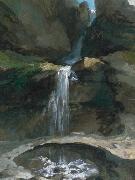 |
Caspar Wolf
|
|
Caspar Wolf (Muri, Aargau, 3 May 1735 - Heidelberg, 6 October 1783) was a Swiss painter, known mostly for his dramatic paintings of Alps. He was strongly influenced by Albrecht von Hallers poem on the Alps, and the Sturm und Drang movement. After 1773 Wolf mostly painted glaciers, caves, waterfalls and gorges.
Wolf was the son of a furniture maker, who was banned from his city. Wolf was trained in Konstanz, between 1753 and 1759 he worked in Augsburg, Munich, Passau as a decoration painter. Not being able to sell his work he went disappointed back to his home town. For Horben Castle he painted by hand the wallpaper on the first floor. In 1768 Wolf lived in Basel. From 1769 till 1771 he stayed in Paris and worked with Philip James de Loutherbourg. In 1774 he moved to Bern. Wolf made a deal with the local publisher Abraham Wagner who had a geological interest, to deliver 200 paintings. He travelled with Wagner or a minister Jakob Samuel Wyttenbach in Berner Oberland and Wallis. From 1780-1781 he was working in Spa, Cologne, Aix-la-Chapelle and Desseldorf. He died in poor circumstances in a hospital.
In 1779 his prints were exposed were Bern but the selling of the book became a failure. Wagner became help from a Swiss army officer in Dutch service and in 1785 30 aquatints were published in Amsterdam. Till 1948 90 of these aquatints were exposed in Keukenhof Castle, but sold. Today these works can be seen in the Kunsthaus in Aarau.
His son Theodor Wolf (1770 - 1818) was a still life painter. |
|
|
|
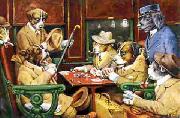 |
Cassius Marcellus Coolidge
|
|
(September 18, 1844?CJanuary 13, 1934) was an American artist, best known for a series of nine paintings of anthropomorphized dogs.
Born in upstate New York to abolitionist Quaker farmers, Coolidge was known to friends and family as "Cash." While he had no formal training as an artist his natural aptitude for drawing led him to create cartoons for his local newspaper when in his twenties. He is credited with creating Comic Foregrounds, life-size cutouts into which one's head was placed so as to be photographed as an amusing character.
In 1903, Coolidge contracted with the advertising firm of Brown & Bigelow of St. Paul, Minnesota, to create sixteen oil paintings of dogs in various human poses. |
|
|
|
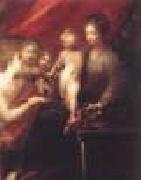 |
CASTELLO, Valerio
|
|
Italian painter, Genoese school (b. 1624, Genova, d. 1659, Genova)
Painter and draughtsman, son of Bernardo Castello. He was one of the leading Ligurian painters of the 17th century, whose art developed from a continuous and passionate study of a wide range of sources. His paintings of mythological and religious subjects unite an elegant figure style with an interest in dramatic and violent compositions; his touch is spontaneous and his palette vibrant with reds and pinks, blues and yellows. His brilliant decorative frescoes introduced the splendour of the High Baroque to Genoese painters. He was well known for his rapid oil sketches, with light and lively brushwork, which anticipate aspects of the Rococo. |
|
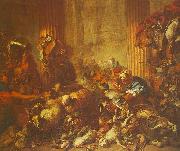 |
CASTIGLIONE, Giovanni Benedetto
|
|
Italian Baroque Era Painter, ca.1609-1664
Painter, printmaker and draughtsman. Most of his works are scenes of the journeys of the patriarchs (e.g. Noah, Abraham, Isaac, Jacob), drawn from the book of Genesis and filled with animals and still-life detail. His oeuvre also, however, includes many spectacular mythological and religious compositions set in expansive landscapes, and for these he found inspiration in Classical mythology, ancient history, Aesop's Fables, 16th-century Italian literature and the lives of the saints. Early biographers claim that he was also a prolific portrait painter, but few examples, save the so-called portrait of Gianlorenzo Bernini (c. 1648-50; Genoa, Pal. Bianco), have been conclusively identified. His surviving subjects reveal his interest in magic and metamorphosis and in philosophical questions such as the frailty of human life, the inevitability of death and the search for truth.
|
|
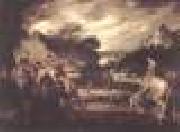 |
CASTILLO, Antonio del
|
|
b. 1616, Cordoba, d. 1668, Cordoba
Spanish painter and draughtsman. He studied first with his father, Agust?n del Castillo (d July 1631), a painter also known for his drawings, and in November 1631 began a three-year apprenticeship with Ignacio de Aedo Calderen, a painter of religious figures ( pintor de imaginera). From 1635 to 1638 Castillo was also known as painter and pintor de imaginera, and by December 1638 |
|
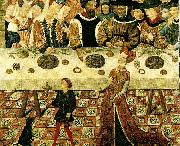 |
catalan school
|
|
banquet of herod
mid-fifteenth century
new york, metropolitan museum |
|
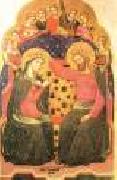 |
CATARINO
|
|
Italian painter, Venetian school (known 1362-1382 in Venice) |
|
 |
CATENA, Vincenzo
|
|
Italian Painter, ca.1480-1531
His paintings represent the perpetuation of the style of Giovanni Bellini into the second quarter of the 16th century. He made few concessions to the modern style that was being introduced to Venice by Titian, Palma Vecchio, Pordenone and others in the same period. This archaicizing tendency was shared by several minor Bellinesque painters of the period, including Pietro degli Ingannati, Pietro Duia, Francesco Bissolo, Vittore Belliniano and the Master of the Incredulity of St Thomas. Catena, together with Marco Basaiti, with whose works Catena's are sometimes confused, can be considered the most accomplished of these. Despite the fact that he counted several humanists in his circle, the extant repertory of his subjects is limited to religious themes, mainly Marian and including three altarpieces, and to male portraits. |
|
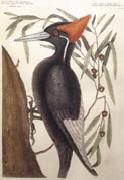 |
Catesby Mark
|
|
English-born artist-naturalist and Traveller, b.c.1679 d.1749
|
|
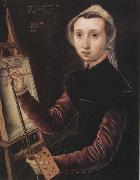 |
Catharina Van Hemessen
|
|
1528-after1587
was a Flemish Renaissance painter. She is the earliest female Flemish painter for whom there is verifiable extant work. As with many Renaissance female painters, she was the daughter of a painter, Jan Sanders van Hemessen (c. 1500-after 1563), who was likely her teacher. She went on to create portraits of wealthy men and women often posed against a dark background. Included in her body of work is a self-portrait done in Basel. She has inscribed the painting with the year, 1548, and her age, 20 years. Her success is marked by her good standing in the Guild of St. Luke and her eventual position as teacher to three male students. Van Hemessen gained an important patron in the 1540s, Maria of Austria, who served as regent of the Low Countries for her brother Charles V. In 1554, she married Christian (or Christien) de Morien, an organist at the Antwerp Cathedral, which was at that time an important post. In 1556, when Maria resigned her post and returned to Spain, Caterina and her husband also moved, on invitation of her patron, to Spain. And two years later, when Maria died, Caterina was given a sizeable pension for life. Caterina and her husband returned to Antwerp. She was mentioned in Guicciardini's Description of the Low Countries of 1567 as one of the living women artists. She died after 1587. She mainly created portraits characterized by realism. The sitters, often seated, were usually seen against a dark or neutral ground. This type of framing and setting made for an intimate portrait. There are no extant works from after 1554, which has led some historians to believe her artistic career might have ended after her marriage. Van Hemessen is often given the distinction of creating the first self-portrait of an artist, of either gender, depicted seated at an easel. |
|
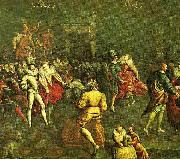 |
caulery
|
|
ball at the valois court.c
1582
rennes, museum |
|
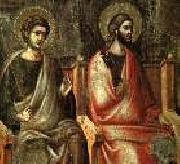 |
CAVALLINI, Pietro
|
|
Italian Gothic Era Painter, ca.1250-1330
Italian painter and mosaicist active mainly in Rome. His major surviving works are mosaics depicting scenes from the life of the Virgin for the Roman church of Santa Maria in Trastevere (1290s) and fragments of a fresco cycle, including a Last Judgment, for the church of Santa Cecilia in Trastevere (c. 1293). He was the first to break with the stylizations of Byzantine art; his figures have a sense of weight and three-dimensionality. Cavallini had many students, |
|
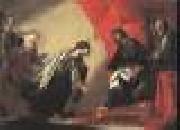 |
CAVALLINO, Bernardo
|
|
Italian Baroque Era Painter, ca.1616-1656
Italian painter and draughtsman. He was the most individual and most poetic painter active in Naples during the first half of the 17th century. He painted mainly small cabinet pictures, on canvas or on copper, for dealers and for highly cultivated private patrons; he had few public commissions and apparently never painted any large-scale decorations for private or ecclesiastical patrons. His subject-matter is largely derived from the Old and New Testaments, the Apocrypha, Tasso and from Roman history and mythology. Documentary evidence for his life and work is almost non-existent, and he remains enigmatic and elusive as a historical figure. Yet as a painter he is strikingly distinctive, uniting a refinement and virtuosity of brushwork with an intensely naturalistic observation of surfaces, and complex and dramatic compositions with an extraordinary brilliance of palette. Only eight pictures are signed, initialled or inscribed with Cavallino's name. No works are documented and only five may be tentatively identified with pictures in mid-18th-century Neapolitan collections described by Bernardo de Dominici. |
|
|

